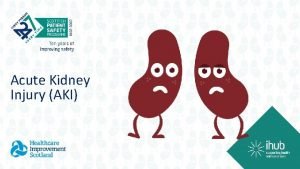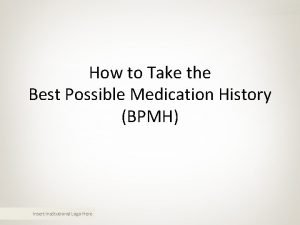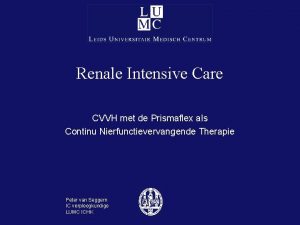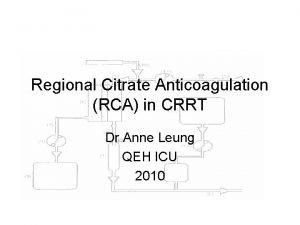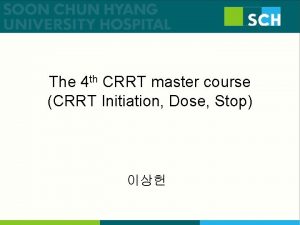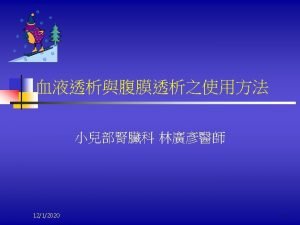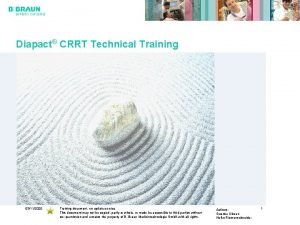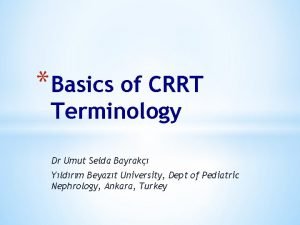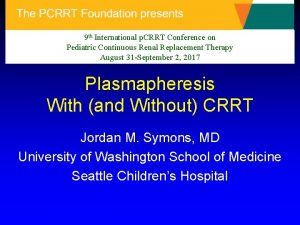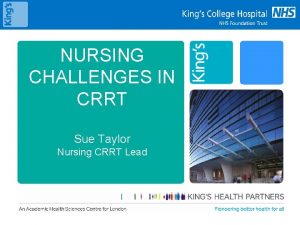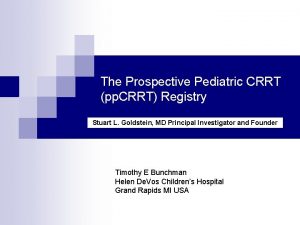CRRT PRE POSTTest AKI CRRT 2021 Question 1













- Slides: 13

CRRT PRE - POST-Test AKI & CRRT 2021

Question 1 § GP is a 47 yo M with Hypertension (HTN), Coronary artery disease (CAD), Obstructive sleep apnea (OSA), Chronic kidney disease (CKD)(baseline creatinine 1. 3 mg/d. L), and obesity (Body Mass Index (BMI) 40) who presented with fever, hypotension, and hypoxemic respiratory failure secondary to COVID-19. Creatinine on admission was 2. 1 mg/d. L. He was initially resuscitated with fluids. § On day 3 Nephrology is consulted for worsening AKI and volume overload unresponsive to high dose diuretics. On examination, he is intubated, sedated, paralyzed, and prone on Assist Control (AC)/Volume Control (VC)36/ Tidal volume 350 / FIO 2 100 / PEEP 20. He is on inhaled epoprostenol and norepinephrine. Urine output the previous 24 h was 540 m. L. Admission weight 110 kg.

Question 1 LABS Blood urea nitrogen Creatinine Electrolytes Sodium Potassium Chloride Bicarbonate ABG 55 mg/d. L 4. 4 mg/d. L (baseline creatinine 1. 3 mg/d. L) Creatinine phosphokinase 18, 000 U/L D-Dimer MAS Ferritin Lactic acid CBC 2, 318 ng/m. L 1995 ng/m. L 1. 6 mmol/L WBC 5, 000 / Hct 30% / platelets 191, 000 SG 1. 015, 2+ protein, 3+ blood, trace ketones, >25 RBCs/hpf Urinalysis 138 m. Eq/L 6. 0 m. Eq/L 105 m. Eq/L 20 m. Eq/L 7. 21 / 58 / 45 on 100% FIO 2

Question 1 Which of the following is the MOST appropriate next step? (Patient weight 120 kg) A. Initiate CVVH with blood flow 200 m. L/min, post filter replacement fluid 1500 m. L/h and fluid removal rate 250 m. L/h B. Initiate CVVH with blood flow 180 m. L/min, pre filter replacement fluid 1000 m. L/h, post filter replacement fluid 1000 m. L/h, and fluid removal rate 100 m. L/h C. Initiate CVVHD with blood flow 150 m. L/min, dialysate rate 2800 m. L/h and fluid removal rate 200 m. L/h D. Initiate CVVHDF with blood flow 250 m. L/min, pre filter replacement fluid 2000 m. L/h, dialysate 2500 m. L/h, post filter replacement fluid 1500 m. L/h, and fluid removal rate 300 m. L/h

Question 2 The patient in the previous case is started on CVVHDF with the following prescription: Blood flow: 200 m. L/min Dialysate: 1800 m. L/h Post-filter replacement fluid: 1000 m. L/h Fluid removal: 100 m. L/h Weight: 110 kg What portion of the effluent rate accounts for convective clearance? A. 10 m. L/kg/h B. 16 m. L/kg/h C. 22 m. L/kg/h D. 26 m. L/kg/h

Question 3 Blood flow: 200 m. L/min Dialysate: 1800 m. L/h Post-filter replacement fluid: 1000 m. L/h Fluid removal: 200 m. L/h The patient in the previous case is on the above CRRT prescription. The ICU pharmacist pages you to ask you the “estimated” clearance being provided with CRRT. The patient is found to have Multi Drug Resistant (MDR) bacteria growing from a recent blood culture and the pharmacist wants to deliver his maintenance antibiotic dose appropriately. The protein binding for the antibiotic is 50%. The volume of distribution is low (30 L). The patient is anuric. What is your answer to the ICU pharmacist? A. Estimated clearance is < 15 m. L/min B. Estimated clearance is ~20 -30 m. L/min C. Estimated clearance is ~40 -50 m. L/min D. Estimated clearance is ~65 -70 m. L/min

Question 4 The patient in the previous case clots his CRRT circuit several times. Therefore he is switched to citrate anticoagulation. He has a double lumen short-term dialysis catheter in his right internal jugular vein with the tip at the cavoatrial junction. His CVVHDF prescription is changed as follows: § Blood flow rate (BFR) = 100 m. L/min § Dialysate rate 1500 m. L/h § Post filter replacement fluid rate 1200 m. L/h § Fluid removal 300 m. L/h § His weight is 110 kg § HCT 30%

Question 4 Blood flow: 100 m. L/min Dialysate: 1500 m. L/h Post-filter replacement fluid: 1200 m. L/h Fluid removal: 300 m. L/h Pt. Weight 110 kg HCT 30% The circuit is anticoagulated with Acid Citrate Dextrose (A-CDA) citrate infused via a port near the arterial access. His post filter i. Ca levels are < 0. 35 mmol/L. The patient develops acute mental status changes and CRRT is disconnected for head CT. When the patient returns from CT, he is restarted on CRRT by the ICU nurse on the same prescription except with a blood flow of 200 m. L/min. Four hours later the CRRT circuit clots. What was the most likely cause of the premature clotting of the circuit? A. Too short dialysis catheter length B. Sub-therapeutic citrate dose C. Increased filtration fraction D. Inadequate dialysis dose

Question 5 A 50 -year-old man is evaluated for AKI after undergoing coronary artery bypass grafting with mitral valve repair. During surgery, his BP fell transiently to 70/40 mm Hg, but the procedure was otherwise uneventful. His medical history includes stage 4 chronic kidney disease (CKD), type 2 diabetes, and hypertension. The patient is intubated and ventilated, receiving 50% fraction of inspired oxygen. The blood pressure is 80/60 mm Hg while receiving an infusion of norepinephrine. Pulse oximetry is 92%. Cardiac examination is unremarkable, but lung examination reveals bibasilar crackles, and extremities have 2+ bilateral edema. Clinical and laboratory data include the following: Admission Day 3 Reference Range Weight 75 kg 80 kg Varies Urine output 1820 m. L/d 460 m. L/d Varies Potassium 4. 7 m. Eq/L 5. 5 3. 5– 5. 0 Blood urea nitrogen (BUN) 41 mg/d. L 98 8– 20 Creatinine 6 0. 7– 1. 3 3 mg/d. L

Question 5 Continuous venous hemofiltration (CVVH) is begun with blood flow of 200 m. L/min, ultrafiltration rate 50 m. L/h, and 1 L/h pre-filter and 1 L/h postfilter replacement fluid. The replacement fluid contains 35 m. Eq/L bicarbonate and 2 m. Eq/L potassium. At day 5, the patient’s BP remains 80/60 mm Hg on the same rate of norepinephrine infusion, and the right leg is mottled with decreased pulses. His potassium is 5. 6 m. Eq/L, BUN 28 mg/d. L, and creatine kinase 25, 000 IU. Which of the following is the next BEST step in management of his renal replacement therapy? A. Change replacement fluid to 0 L/h prefilter and 2 L/h postfilter B. Increase blood flow to 300 m. L/min C. Increase ultrafiltration rate to 150 m. L/h D. Convert to continuous venous hemodialysis with dialysate flow 2 L/h E. Change replacement fluid to 2 L/h prefilter and 2 L/h postfilter

Question 6 A 47 year old 60 kg female with decompensated cirrhosis and chronic hyponatremia develops septic shock and AKI. She is started on CVVHD at dose of 25 m. L/kg/hr and blood flow rate is 150 m. L/min. Fluid removal is 0. Dialysate has the following composition (5 L bag): Na 140 meq/L , K 4 meq/L, Bicarb 35 meq/L , Ca 3 meq/L Patient Labs: Sodium 110 meq/L, Chloride 90 meq/L, Potassium 5. 5 meq/L, Bicarbonate 16 meq/L, BUN 90 mg/d. L, Creatinine 4. 5 mg/d. L, glucose 240 mg/d. L Which of the following management strategies is MOST appropriate for increasing serum sodium by no more than 6 -8 meq/L in 24 hours? A. Remove 500 m. L of fluid from 5 L CRRT solution bag and replace with 500 m. L of sterile water B. Decrease blood flow to 100 m. L/min C. Add 300 m. L of sterile water to 5 L bag of dialysate fluid D. Add D 5 W as post-filter RF at 250 m. L/hr

Question 7 A 63 YO M was admitted to the hospital with septic shock with hypotension requiring pressors and has minimal urine output (80 ml/day). During an employment physical for the Daily Planet last month his Cr was 0. 8 mg/dl. He was diagnosed with rhabdomyolysis, AKI, shock liver and DIC. A right IJ quinton catheter was placed and CRRT was started. Admission Weight: 90 kg, Hct 30%. CRRT Prescription: Machine: Prismaflex Anticoagulation: none Mode: CVVHDF Dose: 25 ml/kg/h Blood flow rate: 200 ml/min Post filter replacement fluid: 2. 5 L Prismasol(BGK 2) all post filter Hourly UF to maintain at even balance 500 ml/h During rounds the next day the nurse tells you that the filter clotted 3 times in the last 24 hours.

Question 7 • • These are the pressures: Access pressure: -70 mm. Hg (-50 to -150 mm. Hg) Return pressure: 90 mm. Hg (50 to 150 mm. Hg) Filter pressure: 350 mm. Hg (100 to 250 mm. Hg) Pressure Drop: 110 mm. Hg TMP: 210 mm. Hg What is the cause of the clotting? A. Clogging of the filter B. Clotting of the filter C. Problem with the dialysis access
 Aki aki aki
Aki aki aki Aki kifelé tekint álmodik aki befelé az ébred
Aki kifelé tekint álmodik aki befelé az ébred Costa question levels
Costa question levels Oral and topical medication administration ati posttest
Oral and topical medication administration ati posttest Dosage abbreviations chart
Dosage abbreviations chart Pill identifier
Pill identifier Statistisk validitet
Statistisk validitet Cvvh catheter
Cvvh catheter Prismaflex crrt troubleshooting
Prismaflex crrt troubleshooting Crrt training course
Crrt training course Crrt training course 2020
Crrt training course 2020 Diapact crrt braun manual
Diapact crrt braun manual Diapact crrt
Diapact crrt Crrt conference
Crrt conference
